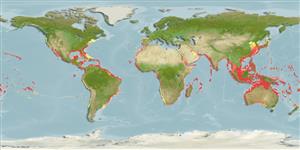Common names from other countries
Environment: milieu / climate zone / depth range / distribution range
Sinh thái học
Biển Cùng sống ở rạn san hô; Mức độ sâu 2 - 200 m (Ref. 5951), usually 2 - 35 m (Ref. 40849). Subtropical; 37°N - 39°S, 8°E - 55°W (Ref. 55210)
Circumtropical in distribution. Western Atlantic: Canada (Ref. 5951), Florida, USA and the Bahamas to Brazil (Ref. 7251). Eastern Atlantic: 30°N to 23°S (Ref. 6951); also South Africa (Ref. 4423). Western Indian Ocean: southern Red Sea to Madagascar, Reunion and Mauritius (Ref. 53568). Pacific Ocean: southern Japan south to Lord Howe Island and east to the Hawaiian and Easter islands (Ref. 37816). Also from southern California, USA to Colombia (Ref. 11482) and the Galapagos Islands (Ref. 5227).
Bộ gần gũi / Khối lượng (Trọng lượng) / Age
Maturity: Lm ? range ? - ? cm
Max length : 50.0 cm TL con đực/không giới tính; (Ref. 7251); common length : 15.0 cm TL con đực/không giới tính; (Ref. 55763)
Các tia vây lưng cứng (tổng cộng) : 0; Các vây lưng mềm (tổng cộng) : 13 - 15; Tia cứng vây hậu môn: 0; Tia mềm vây hậu môn: 13 - 15. Pelagic juveniles with spots, particularly prominent on belly; adults with dark blotches across back and spots between the blotches; fins without spots (Ref. 4423). 14 to 16 spines in an approximate row between snout and origin of dorsal fin; with a large brown bar above and below each eye; a broad transverse brown bar on occipital region of head (Ref. 13442).
Inhabit shallow reefs to open, soft bottoms. Also in areas with rocky substrata. Sometimes form groups (Ref. 9710, 48637). Occur on open muddy substrates as well as on rich soft-bottom and coral reefs. Juveniles often with floating Sargassum rafts. Young and sub-adults may form small groups (Ref. 48637). Benthopelagic (Ref. 58302). Juveniles pelagic to about 6-9 cm. Solitary. Feed on mollusks, sea urchins, hermit crabs, and crabs at night (Ref. 9680). Relatively poor swimmers (Ref. 9710). Used in Chinese medicine (Ref. 12166). Captured at the surface using a hand net (Ref. 26165).
Leis, J.M., 1984. Diodontidae. In W. Fischer and G. Bianchi (eds.) FAO species identification sheets for fishery purposes. Western Indian Ocean fishing area 51. Vol. 2. (Ref. 3393)
IUCN Red List Status (Ref. 130435)
CITES (Ref. 128078)
Not Evaluated
Threat to humans
Reports of ciguatera poisoning (Ref. 30303)
Human uses
Các nghề cá: buôn bán nhỏ; Bể nuôi cá: Tính thương mại
Các công cụ
Special reports
Download XML
Các nguồn internet
Estimates based on models
Preferred temperature (Ref.
115969): 21.5 - 29, mean 27.3 (based on 2666 cells).
Phylogenetic diversity index (Ref.
82804): PD
50 = 0.5313 [Uniqueness, from 0.5 = low to 2.0 = high].
Bayesian length-weight: a=0.05888 (0.02847 - 0.12178), b=2.80 (2.61 - 2.99), in cm Total Length, based on LWR estimates for this species & (Sub)family-body (Ref.
93245).
Mức dinh dưỡng (Ref.
69278): 3.9 ±0.2 se; based on diet studies.
Thích nghi nhanh (Ref.
120179): Chiêù cao, thời gian nhân đôi của chủng quần tối thiểu là dưới 15 tháng (Preliminary K or Fecundity.).
Fishing Vulnerability (Ref.
59153): Low to moderate vulnerability (27 of 100).
